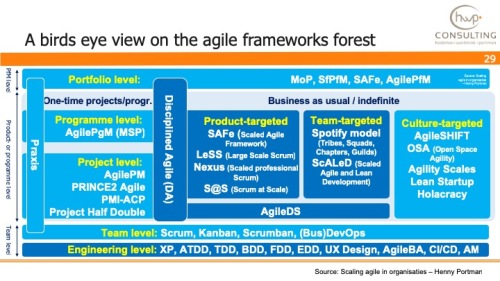 Scott W. ambler and Mark Lines are the creators of the Disciplined Agile Delivery framework and the authors of the book Introduction to Disciplined Agile Delivery – a small Agile Team’s journey from Scrum to Disciplined DevOps (2ndedition).
Scott W. ambler and Mark Lines are the creators of the Disciplined Agile Delivery framework and the authors of the book Introduction to Disciplined Agile Delivery – a small Agile Team’s journey from Scrum to Disciplined DevOps (2ndedition).
Disciplined Agile Delivery (DAD) is one of the four elements of Disciplined Agile (DA). The other parts are Disciplined DevOps, Disciplined Agile IT (DAIT) and Disciplined Agile Enterprise (DAE).
DAD is characterized by the following aspects:
- Hybrid: combines Scrum, Agile Modelling, XP, Unified Process, Kanban, Lean, Outside-In Development (OID) and other methods
- Full delivery cycle. Scrum offers only a development cycle. DAD starts from team initiation all the way to delivering the solution to its end users
- Supports multiple lifecycles based on inception, construction and transition: an agile/basic version that extends the Scrum construction lifecycle with proven ideas form Unified Process to support early mitigation of risk and lightweight governance; an advanced/lean lifecycle based on Kanban; an agile continuous delivery lifecycle; a lean continuous lifecycle; and an exploratory lifecycle based upon a Lean Start-up approach
- Complete: DAD includes advice how development, modeling, documentation, and governance strategies fit together
- Context-sensitive: instead of prescriptive frameworks like Scrum, DAD promotes a goal- or object-driven approach.
The core of the book is a case study. We follow a team on their journey to use DAD and more specific the Scrum-based agile/basic lifecycle. It starts, after the introduction of the team and other stakeholders, with the Inception phase. The goals of the Inception phase are: form initial team, develop common vision, align with enterprise direction, explore initial scope, identify initial technical strategy, develop initial release plan, secure funding, form work environment, identify risks and develop initial test strategy.
In the construction phase the team uses, as described in the release plan, ten construction iterations to produce a potentially shippable solution. Every iteration starts with an iteration planning cycle. Every day there will be a coordination meeting and the iteration ends with the iteration review/demo and the retrospective. Additional to scrum, DAD will have a proven architecture and the sufficient functionality milestone reviews too and you have to pass both successfully before you can go into the Transition phase.
The focus of the Transition phase is for a team to release/deploy their consumable solution into production successfully. To ensure that the solution is ready to deploy the team focusses on the final testing and fixing, the support training of the helpdesk staff, the finalization of the deliverable documentation, the support of the development of end-user training (videos), and the validation of the deployment scripts.
As a next step we follow the team on their road to Disciplined DevOps. In this case the team decided to have seven 2-week iterations. Some highlights of the iterations are the adoption of Test Driven Development (TDD), working from home, improvement tracking, the evolvement of the team, the usage of parallel independent testing, how to cope with vacations and the sharing of their learnings, ATDD or BDD training and adoption, requirements envisioning, quality and continuous integration and deployment. At a certain moment, after several releases, the release cadence was tightened, and their lifecycle evolved towards the lean lifecycle and the team stopped with sizing their work.
Conclusion: if you are looking for a comprehensive overview of DAD this is the book to read. The case gives a good overview of the Scrum-based agile/basic lifecycle and may help you to take the first steps to implement DAD.
More information can be found on disciplinedagileconsortium.org
To order (Managementboek.nl): Introduction to Disciplined Agile Delivery
To order (Amazon): Introduction to Disciplined Agile Delivery
Disciplined Agile and Disciplined Agile Delivery positioned in my birds eye view on the agile forest

















Pingback: New PM Articles for the Week of March 11 – 17 | The Practicing IT Project Manager
Pingback: Review: An executive’s guide to disciplined agile | Henny Portman's Blog
Pingback: Overview of my year 2019 book reviews | Henny Portman's Blog